It’s very close to the end of December as I’m writing this, but we’ll be well into the new year by the time the piece actually appears on the FishingMagic site. I hope you’ve all enjoyed a stress free Christmas and had a fabulous start to your new year.
In my last piece I was hinting that conditions and work responsibilities were starting to impinge upon my actual fishing time. As it happens the last month or so has been even worse and I’ve not been able to wet a line since submitting my last diary piece. I can’t actually remember the last time I didn’t manage to go fishing for a whole month, so it’s been something of a culture shock to say the least!
The same set of restrictions that were starting to impact upon my fishing towards the end of November have still been relevant over the last month, but have been joined by a couple of new ones, in the shape of Christmas and the fact that my girlfriend and I have found a new house. If the house buying and selling paperwork and contracts are signed as quickly as initial indications have suggested, then we’re quite likely to be moving in the next month or so!
My girlfriend has recently changed jobs and I’m in the middle of an important and very work-intensive contract, so we’ve both been working flat out. Finding a new house and all the associated activities have therefore been conducted at the weekends, so with that added to the usual family related Christmas celebrations it’s left very little opportunity to get out on the bank. The few opportunities there have been have occurred when conditions have been awful, so it’s just not happened.
With work likely to be totally ‘full-on’ for a while yet and all the activity associated with an actual house move to be organised and performed, I can see my fishing plans still being impacted for a good few weeks to come. I guess that I’m just going to have to grit my teeth and simply get on with things while I look forward to later in the year when I can allow my fishing to jump back up the priority list.
This time of year is when I tend to do a certain amount of planning for the months ahead, but it looks as though I’ll have to build in an extra amount of flexibility in the early part of the year to account for the likely move and all of the disruption that will inevitably follow.
Despite everything else getting in the way, one of the few fishing related things that I’ve been able to progress with has been a certain amount of bait preparation, hoping that I’ll be able to grab the odd evening session on the river after chub at some point in the not too distant future.
One of the simplest, and it has to be said one of my favourite and most successful, baits / methods for river chubbing has to be breadflake on a very straightforward link-ledger type set up. This is my default ‘go anywhere’ chub combo, which has helped me catch good chub from several different rivers including a couple of 7lb plus fish. The basic rig consists of nothing more than the main line, hooklink material, a ledger weight and the hook itself, and with a few slices from a fresh sliced loaf you’re ‘good to go’.
As with most basic baits and methods though, a little bit of thought and a bit of extra effort can provide some useful variations based on the original idea. These can certainly offer something a little bit different when the basic set up has been used too often and the fish are starting to wise up and in certain conditions they may even be an improvement on the original.
Using basic breadflake as bait is often used as a hookbait-only tactic, without any further free offerings used, as either a source of attraction or confidence inducing freebies. Obviously placing free offerings of breadflake with any amount of accuracy is a little haphazard especially trying to guess the effect of the current on individual pieces of flake, even if you can manage to throw them out somewhere towards where you want them.
Alternatively, a bucket of ‘mashed’ bread is often used in conjunction with breadflake hookbaits. A popular tactic is to walk the stretch and introduce a handful or two of ‘mash’ to the swims to be fished before walking back to the start and fishing each swim in turn. Again though, while obviously more accurate than trying to throw in bits of breadflake, it still seems a little haphazard for my liking, especially when the ‘mash’ needs to be introduced during the hours of darkness.
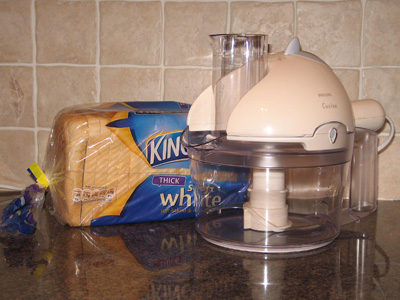 The first thing I like to do when using breadflake on the hook, but when I want to introduce some sort of additional attractor, is to swap the ledger weight for an open-ended feeder and use ‘liquidised’ bread. This ‘liquidised’ bread isn’t a liquid of course, just chopped up into very fine little particles using a food processor. It’s a bit of a favourite with the match fishing guys who want to attract fish to the area with additional smell and visual attraction without providing anything much for the fish to actually eat (and therefore fill themselves up on).
The first thing I like to do when using breadflake on the hook, but when I want to introduce some sort of additional attractor, is to swap the ledger weight for an open-ended feeder and use ‘liquidised’ bread. This ‘liquidised’ bread isn’t a liquid of course, just chopped up into very fine little particles using a food processor. It’s a bit of a favourite with the match fishing guys who want to attract fish to the area with additional smell and visual attraction without providing anything much for the fish to actually eat (and therefore fill themselves up on).
I tend to prepare a reasonable quantity of liquidised bread in one go, which can be prompted when I happen across a batch of cheap sliced bread at the supermarket that’s been discounted due to getting to close to its sell by date. While you want the freshest bread possible for hookbait, slightly older bread is ideal for liquidising and the cheaper supermarket bread is as good as any other.
Preparing liquidised bread is really simple, so long as you have access to a decent food processor/blender. I’ve actually got my own for various bait making activities, but the wife or girlfriend will probably have one tucked away in a kitchen cupboard somewhere. You may have to explain to the ‘other half’ that you’re only going to use the processor to liquidise bread rather than create some disgusting smelling paste concoction; my girlfriend certainly gets suspicious every time I look as though I’m about to embark on some bait related kitchen activity.
If you’ve never used a food processor before, either ask the ‘other half’ to show you what to do, or read the instructions carefully. You don’t want to either break the machine or chop the ends of your fingers off! Once you’ve got the hang of it though the actual process itself is really quite quick and easy. Just make sure you only do relatively small batches at a time and make sure the bread is thoroughly chopped up into really tiny little particles. I tend to chop off most of the crust before feeding the bread into the processor, but I’m not sure that it makes too much difference and it may be possible to just leave the crust on if you’re feeling particularly lazy.
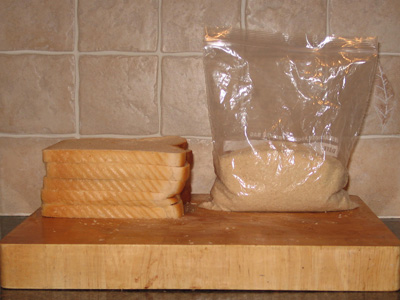 You may be surprised at first how much bread seems to result in a relatively small amount of liquidised end product. Don’t worry though, as a small amount of liquidised bread goes a long way, so there’s no need to make up large bags of the stuff. I use quite small freezer bags to store the bread and then transfer the bags into the freezer for long term storage. I might also prepare a batch of hookbait slices at the same time, as there’s no point in taking a whole loaf as hookbait (unless you have to buy in on the way to the venue) and I find that five slices of thick-sliced white bread will provide enough hookbaits for the longest of evening sessions… even if I do find myself staying on the river until the early hours.
You may be surprised at first how much bread seems to result in a relatively small amount of liquidised end product. Don’t worry though, as a small amount of liquidised bread goes a long way, so there’s no need to make up large bags of the stuff. I use quite small freezer bags to store the bread and then transfer the bags into the freezer for long term storage. I might also prepare a batch of hookbait slices at the same time, as there’s no point in taking a whole loaf as hookbait (unless you have to buy in on the way to the venue) and I find that five slices of thick-sliced white bread will provide enough hookbaits for the longest of evening sessions… even if I do find myself staying on the river until the early hours.
Remember to use the freshest bread you can get for hookbait though. For hookbaits I usually split a sliced loaf into four separate batches of five or six slices each and store in separate freezer bags. Take the hookbait slices and a bag of liquidised bread out of the freezer the morning before your evening session and it should be ‘spot on’ by the start of your session. Obviously for a day session you can take the bait out of the freezer the evening before. Don’t panic if you’ve just decided on a last minute session, or have simply forgotten to take the bait out of the freezer prior to your session as it starts to thaw really quickly and you get to the venue you can always pop a bag of bait down your jacket and let body heat speed up the thawing process if necessary.
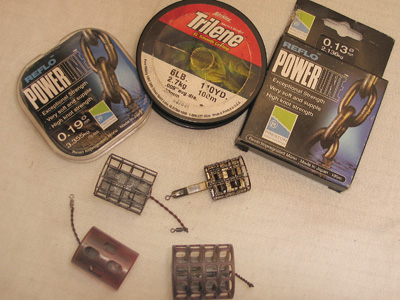 The way I usually use the liquidised bread is to use the lightest open-ended swimfeeder I can get away with instead of a ledger weight on a simple link ledger type rig. I use a hooklink of a lighter breaking strain than my mainline and a decent sized, sharp but reasonably lightweight hook. To fill the feeder I sit with the bag of bread in my lap and drop the feeder inside then, with the ends of the feeder between forefinger and thumb, I just pinch the liquidised bread together inside of the feeder to hold it in, pinching more layers of liquidised bread in if necessary until the feeder is holding the correct amount, or is full.
The way I usually use the liquidised bread is to use the lightest open-ended swimfeeder I can get away with instead of a ledger weight on a simple link ledger type rig. I use a hooklink of a lighter breaking strain than my mainline and a decent sized, sharp but reasonably lightweight hook. To fill the feeder I sit with the bag of bread in my lap and drop the feeder inside then, with the ends of the feeder between forefinger and thumb, I just pinch the liquidised bread together inside of the feeder to hold it in, pinching more layers of liquidised bread in if necessary until the feeder is holding the correct amount, or is full.
Then the hook is baited with flake as normal and I’m ready to cast. As I said, I like to use as light a swimfeeder as I can get away with, but it’s also very important to have the feeder stay in the one spot and not to be swept about by the current and bounce around all over the swim. If the feeder is moving about it will only serve to spread the liquidised bread around, whereas what you’re trying to achieve is a nicely concentrated line of the tiny bread particles distributed downstream from your feeder very close to your flake hookbait, with minute particles of bread and the bread smell washing downstream to hopefully attract chub upstream towards the hookbait.
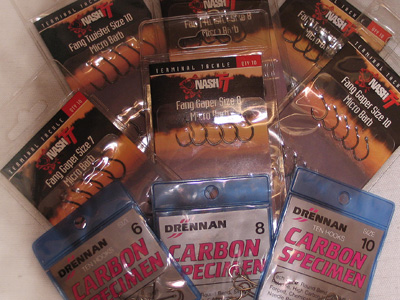 The size of hook is normally matched to the size of hookbait. For chub fishing a size 6 with a decent-sized lump of flake is my usual starting point, usually only switching to a smaller-sized hookbait and hook if bites are hard to come by. There are no fixed rules about this though and occasionally experimenting with much larger pieces of flake can produce a bite when all else fails. Whatever the hook size remember to keep the hook point sharp and be prepared to change the hook if it doesn’t feel ‘sticky’ sharp.
The size of hook is normally matched to the size of hookbait. For chub fishing a size 6 with a decent-sized lump of flake is my usual starting point, usually only switching to a smaller-sized hookbait and hook if bites are hard to come by. There are no fixed rules about this though and occasionally experimenting with much larger pieces of flake can produce a bite when all else fails. Whatever the hook size remember to keep the hook point sharp and be prepared to change the hook if it doesn’t feel ‘sticky’ sharp.
There are no fixed rules about the length of the hooklink either. As I’m probably not as quick at hitting the bites as I used to be I imagine that a longer hooklink gives me a little more time to hit the bites so I tend to favour longer links. However, there’s definitely scope for plenty of experimentation. My starting point here is probably a hooklink of about 2ft long, but it’s certainly worth swapping and changing if bites are coming, but you’re not connecting with them on the strike.
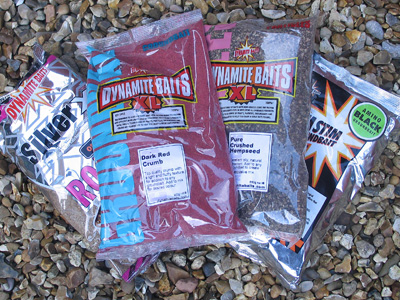 Incorporating liquidised bread can give the more traditional ledgered breadflake a new lease of life, but the changes don’t necessarily have to stop at simply liquidising the bread. The use of flavours, both on the flake hookbait and on the liquidised bread feed, can add an entire new dimension to the method and provide a whole new avenue of possibilities to experiment with and explore.
Incorporating liquidised bread can give the more traditional ledgered breadflake a new lease of life, but the changes don’t necessarily have to stop at simply liquidising the bread. The use of flavours, both on the flake hookbait and on the liquidised bread feed, can add an entire new dimension to the method and provide a whole new avenue of possibilities to experiment with and explore.
Then there’s the use of other liquidised ingredients, such as various groundbaits, pellets, boilie mixes and seeds (like hemp) to consider blending with the bread. All of these additional alternatives are probably worth looking at as a separate article altogether, so I’ll perhaps go into further detail at some other time. It’s all food for thought though and helps to demonstrate how simple methods and baits can sometimes evolve into something quite different and potentially unique given a little thought and effort.










